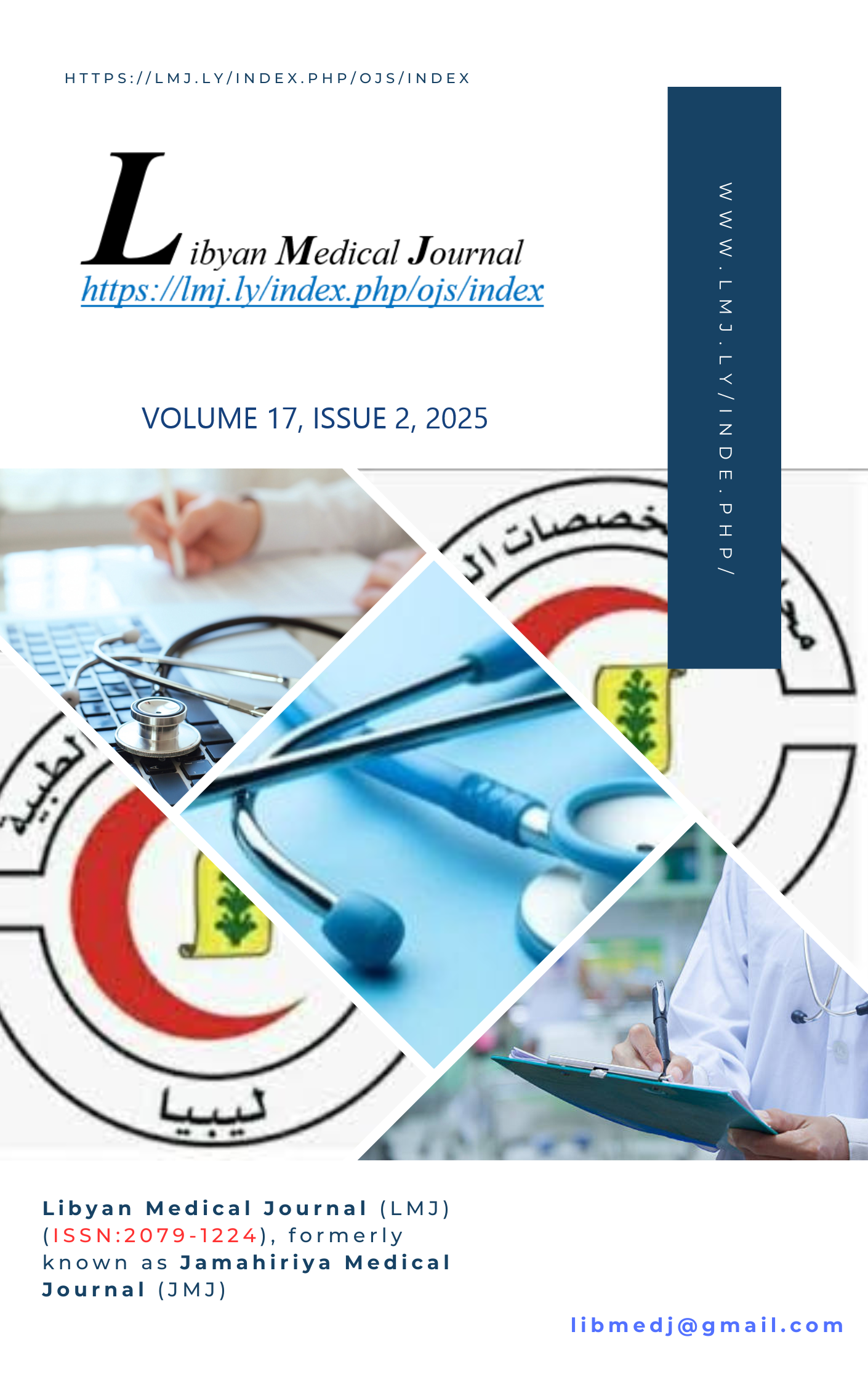Determining the Contents of Antioxidants, Total Phenols, Carbohydrate, Total Protein, and Some Elements in Eucalyptus Gomphocephala and Ricinus Communis Plant Samples
DOI:
https://doi.org/10.69667/lmj.2517216Keywords:
Chemical Analysis, Eucalyptus gomphocephala, Ricinus Communis.Abstract
A comparative chemical study was carried out on two plants (Eucalyptus gomphocephala and Ricinus communis) growing at coastal (Derna city) and Mountain (Al-Bayda city) regions. Leaves and stems of each plant were selected in this study. Some of the chemical constituents (Antioxidant, total phenols, total protein, carbohydrate, minerals, and metals) were estimated. The chemical properties results showed wide variations of the anti –oxidant contents, where high values of (390.90 ppm) were recorded in Eucalyptus gomphocephala growing at Al- Bayda region, On the other side high contents of anti- oxidant of (447.5 ppm) was recorded in leafs of Ricinus communis plant growing in Deran region. Small variations of carbohydrate contents were observed; their contents fluctuated in the range of (0.001 – 0.870 ppm), and the contents of protein ranged between (0.74 – 4.40 ppm). For the mineral contents, the recorded high values of potassium (126 – 447.70 ppm), high values were recorded in leafs comparing with steams of the studied plants, relative high contents of sodium were recorded in coastal regions (44.93 ppm) compared with the Mountain ones (13.85) higher values were recorded in Ricinus communis comparing with Eucalyptus gomphocephala plant. No wide variations were recorded for (iron), (copper), and (Nickel).
References
Al-Sayed E, Martiskainen O, Bobrowska-Hägerstrand M, Sinkkonen J, Törnquist K, Pihlaja K, Singab AN. Phenolic compounds from Eucalyptus gomphocephala with potential cytotoxic and antioxidant activities. Nat Prod Commun. 2010;5(10).
Edwards TA. Environmental correlates and associations of tuart (Eucalyptus gomphocephala) decline. 2004.
Kadri A, Gharsallah N, Damak M, Gdoura R. Chemical composition and in vitro antioxidant properties of essential oil of Ricinus communis L. J Med Plants Res. 2010;5(8):1466-70.
Rana M, Dhamija H, Prashar B, Sharma S. Ricinus communis L. – A review. Int J PharmTech Res. 2012;4(4):1706-11.
Santos PM, Batista DL, Ribeiro LA, Boffo EF, de Cerqueira MD, Martins D, Ribeiro RP. Identification of antioxidant and antimicrobial compounds from the oilseed crop Ricinus communis using a multiplatform metabolite profiling approach. Ind Crops Prod. 2018;124:834-44.
Jena J, Gupta AK. Ricinus communis Linn: a phytopharmacological review. Int J Pharm Pharm Sci. 2012;4(4):25-9.
Ribeiro PR, de Castro RD, Fernandez LG. Chemical constituents of the oilseed crop Ricinus communis and their pharmacological activities: A review. Ind Crops Prod. 2016;91:358-76.
Sotelo-Leyva C, Salinas-Sánchez DO, Peña-Chora G, Trejo-Loyo AG, González-Cortázar M, Zamilpa A. Insecticidal compounds in Ricinus communis L. (Euphorbiaceae) to control Melanaphis sacchari Zehntner (Hemiptera: Aphididae). Fla Entomol. 2020;103(1):91-5.
Batish DR, Singh HP, Kohli RK, Kaur S. Eucalyptus essential oil as a natural pesticide. For Ecol Manag. 2008;256(12):2166-74.
Deore AC, Johnson TS. High-frequency plant regeneration from leaf-disc cultures of Jatropha curcas L.: an important biodiesel plant. Plant Biotechnol Rep. 2008;2(1):7-11.
Alam I, Sharmin SA, Mondal SC, Alam J, Khalekuzzaman M, Anisuzzaman M, Alam MF. In vitro micropropagation through cotyledonary node culture of castor bean (Ricinus communis L.). Aust J Crop Sci. 2010;4(2):81-4.
Rajarathinam A, Parmar RS. Application of parametric and nonparametric regression models for area, production and productivity trends of castor (Ricinus communis L.) crop. Asian J Appl Sci. 2011;4(1):42-52.
Arif M, Khurshid H, Siddiqui SU, Jatoi SA, Jan SA, Ilyas M, Ghafoor A. Estimating spatial population structure through quantification of oil content and phenotypic diversity in Pakistani castor bean (Ricinus communis L.) germplasm. Sci Technol Dev. 2015;34(3):147-51.
Foster JT, Allan GJ, Chan AP, Rabinowicz PD, Ravel J, Jackson PJ, Keim P. Single nucleotide polymorphisms for assessing genetic diversity in castor bean (Ricinus communis). BMC Plant Biol. 2010;10:1-11.
Food and Agriculture Organization (FAO). FAOSTAT. 2006. Available from: http://faostat.fao.org
Mahmoud SA, Hasan HM, Abdul Salam NA. Phytochemical screening, total phenolic, antioxidant, metals and mineral contents in some parts of Plantago albicans grown in Libya. World J Pharm Res. 2024;1(3).
Elsalhin H, Abobaker HA, Hasan H, El-Dayek GA. Antioxidant capacity and total phenolic compounds of some algae species (Anabaena and Spirulina platensis). Sch Acad J Biosci. 2016;4(10):782-6.
Hasan HM, Ibrahim H, Gonaid MA, Mojahidul I. Comparative phytochemical and antimicrobial investigation of some plants growing in Al Jabal Al-Akhdar. J Nat Prod Plant Resour. 2011;1(1):15-23.
Alaila AK, El Salhin HE, Ali RF, Hasan HM. Phytochemical screening of some herbal plants (Mentha, Origanum and Salvia) growing at Al-Gabal Al-Akhdar region, Libya. Int J Pharm Life Sci. 2017;8(4).
Hamade MH, Abdelraziq SA, Gebreel AA. Extraction and determination of beta-carotene content in carrots and tomato samples collected from some markets at El-Beida City, Libya. EPH Int J Appl Sci. 2019;1(1):105-10.
Hasan H, Jadallah S, Zuhir A, Ali F, Saber M. The anti-cancer, anti-inflammatory, antibacterial, antifungal, antioxidant and phytochemical investigation of flowers and stems of Anacyclus clavatus plant extracts. AlQalam J Med Appl Sci. 2025:415-27.
Hasan H, Zuhir A, Shuib F, Abdraba D. Phytochemical investigation and exploring the Citrullus colocynthis extracts as antibacterial agents against some Gram-positive and negative bacteria species. AlQalam J Med Appl Sci. 2025:392-400.
Hamad MAS, Ali AR. Separation and identification the speciation of the phenolic compounds in fruits and leaves of some medicinal plants (Juniperus phoenicea and Quercus coccifera) growing at Al-Gabal Al-Akhdar region, Libya. Indian J Pharm Educ Res. 2016;51(3):299-303.
Aljamal MA, Hasan HM, Al Sonosy HA. Antibacterial activity investigation and antibiotic sensitivity for different solvents (ethanol, propanol, DMSO and diethyl ether) extracts of seeds, leaves and stems of (Laurus azorica and Avena sterilis) plants. Int J Curr Microbiol Appl Sci. 2024;13(11):175-90.
Eltawaty SA, Abdalkader GA, Hasan HM, Houssein MA. Antibacterial activity and GC-MS analysis of chloroform extract of bark of the Libyan Salvia fruticosa Mill. Int J Multidiscip Sci Adv Technol. 2021;1(1):715-21.
MdZeyaullah RA, Naseem A, Badrul I, Hamad MI, Azza SA, Faheem AB, Moshed AR, Arif A. Catechol biodegradation by Pseudomonas strain: a critical analysis. Int J Chem Sci. 2009;7(3):2211-21.
Gonaid MI, Ibrahim H, Al-Arefy HM. Comparative chemical and biological studies of Salvia fruticosa, Ocimum basilicum and Pelargonium graveolens cultivated in Al-Jabal Al-Akhdar. J Nat Prod Plant Resour. 2012;6(2):705-10.
Nabil B, Hamad H, EL-Denalia A. Determination of Cu, Co, and Pb in selected frozen fish tissues collected from Benghazi markets in Libya. Chem Methodol. 2018;2(1):56-63.
Mamdouh SM, Wagdi ME, Ahmed MA, Alaa EA, Essam AM, Hamad MIH. Rice husk and activated carbon for wastewater treatment of El-Mex Bay, Alexandria Coast, Egypt. Arab J Chem. 2016;9:1590-6.
Mamdouh SM, Wagdi ME, Ahmed MA, Alaa EA, Hamad MIH. Distribution of different metals in coastal waters of Alexandria, Egypt. Egypt Sci Mag. 2010;7(1):1-19.
Hasan HM. Studies on physicochemical parameters and water treatment for some localities along coast of Alexandria [Ph.D. thesis]. Alexandria: Faculty of Science, Alexandria University; 2006. 256 p.
Hamad MI, Mojahid U. The concentrations of some heavy metals of Al-Gabal Al-Akhdar coast sediment. Arch Appl Sci Res. 2010;2(6):59-67.
Mohamed AE, Afnan SA, Hamad MA, Mohammed AA, Mamdouh SM, Alaa RE, Mohammed G. Usage of natural wastes from animal and plant origins as adsorbents for the removal of some toxic industrial dyes and heavy metals in aqueous media. J Water Process Eng. 2023;55.
Mamdouh SM, Wagdi ME, Ahmed A, Alaa EA, Hamad MIH. Bulletin of the Faculty of Science. 2012;47(1-2):12-28.
Shahidi F, Ambigaipalan P. Phenolics and polyphenolics in foods, beverages and spices: Antioxidant activity and health effects – A review. J Funct Foods. 2015;18:820-97.
Taârit MB, Msaada K, Hosni K, Marzouk B. Physiological changes, phenolic content and antioxidant activity of Salvia officinalis L. grown under saline conditions. J Sci Food Agric. 2012;92(8):1614-9.
Rastall RA. Methods in Plant Biochemistry. Volume 2. Carbohydrates. London: Academic Press; 1990.
Stick RV, Williams S. Carbohydrates: the essential molecules of life. London: Elsevier; 2010.
Martínez-Cuenca MR, Primo-Capella A, Forner-Giner MA. Influence of rootstock on Citrus tree growth: effects on photosynthesis and carbohydrate distribution, plant size, yield, fruit quality, and dwarfing genotypes. Plant Growth. 2016;16:107.
De Schutter K, Van Damme EJ. Protein-carbohydrate interactions as part of plant defense and animal immunity. Molecules. 2015;20(5):9029-53.
Ashraf MPJC, Harris PJC. Potential biochemical indicators of salinity tolerance in plants. Plant Sci. 2004;166(1):3-16.
Zhu B, Zheng Y, Pham AD, Mandal SS, Erdjument-Bromage H, Tempst P, Reinberg D. Monoubiquitination of human histone H2B: the factors involved and their roles in HOX gene regulation. Mol Cell. 2005;20(4):601-11.
Peng C, Uygun S, Shiu SH, Last RL. The impact of the branched-chain ketoacid dehydrogenase complex on amino acid homeostasis in Arabidopsis. Plant Physiol. 2015. http://dx.doi.org/10.1104/pp.1115.0046











